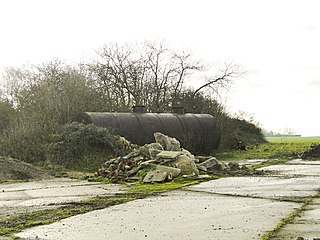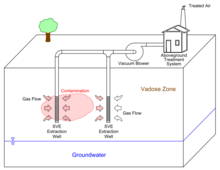
Environmental remediation is the cleanup of hazardous substances dealing with the removal, treatment and containment of pollution or contaminants from environmental media such as soil, groundwater, sediment. Remediation may be required by regulations before development of land revitalization projects. Developers who agree to voluntary cleanup may be offered incentives under state or municipal programs like New York State's Brownfield Cleanup Program. If remediation is done by removal the waste materials are simply transported off-site for disposal at another location. The waste material can also be contained by physical barriers like slurry walls. The use of slurry walls is well-established in the construction industry. The application of (low) pressure grouting, used to mitigate soil liquefaction risks in San Francisco and other earthquake zones, has achieved mixed results in field tests to create barriers, and site-specific results depend upon many variable conditions that can greatly impact outcomes.

Bioremediation broadly refers to any process wherein a biological system, living or dead, is employed for removing environmental pollutants from air, water, soil, flue gasses, industrial effluents etc., in natural or artificial settings. The natural ability of organisms to adsorb, accumulate, and degrade common and emerging pollutants has attracted the use of biological resources in treatment of contaminated environment. In comparison to conventional physicochemical treatment methods bioremediation may offer considerable advantages as it aims to be sustainable, eco-friendly, cheap, and scalable.
Thermal desorption is an environmental remediation technology that utilizes heat to increase the volatility of contaminants such that they can be removed (separated) from the solid matrix. The volatilized contaminants are then either collected or thermally destroyed. A thermal desorption system therefore has two major components; the desorber itself and the offgas treatment system. Thermal desorption is not incineration.

Soil contamination, soil pollution, or land pollution as a part of land degradation is caused by the presence of xenobiotic (human-made) chemicals or other alteration in the natural soil environment. It is typically caused by industrial activity, agricultural chemicals or improper disposal of waste. The most common chemicals involved are petroleum hydrocarbons, polynuclear aromatic hydrocarbons, solvents, pesticides, lead, and other heavy metals. Contamination is correlated with the degree of industrialization and intensity of chemical substance. The concern over soil contamination stems primarily from health risks, from direct contact with the contaminated soil, vapour from the contaminants, or from secondary contamination of water supplies within and underlying the soil. Mapping of contaminated soil sites and the resulting clean ups are time-consuming and expensive tasks, and require expertise in geology, hydrology, chemistry, computer modelling, and GIS in Environmental Contamination, as well as an appreciation of the history of industrial chemistry.

Vapor intrusion (VI) is the process by which chemicals, usually volatile organic compounds (VOCs), in soil or groundwater migrate to indoor air above or around a contaminated site. The process of VI has been studied more recently in relation to its effects on humans and the environment, and is becoming more regulated by the United States Environmental Protection Agency.
A thermal blanket is a device used in thermal desorption to clean soil contamination. The primary function of a thermal blanket is to heat the soil to the boiling point of the contaminants so that they break down. A vacuum pulls the resulting gas into a separate air cleaner that may use various methods, such as carbon filters and high-heat ovens, to completely destroy the contaminants. Aside from evaporation and volatilization, the contaminants may also be removed from the soil through other mechanisms such as steam distillation, pyrolysis, oxidation, and other chemical reactions.
AMCO Chemical was a chemical distribution company located in Oakland, California. The land the company operated on is designated as a U.S. Environmental Protection Agency (EPA) Superfund cleanup site.
Groundwater remediation is the process that is used to treat polluted groundwater by removing the pollutants or converting them into harmless products. Groundwater is water present below the ground surface that saturates the pore space in the subsurface. Globally, between 25 per cent and 40 per cent of the world's drinking water is drawn from boreholes and dug wells. Groundwater is also used by farmers to irrigate crops and by industries to produce everyday goods. Most groundwater is clean, but groundwater can become polluted, or contaminated as a result of human activities or as a result of natural conditions.

Electrical resistance heating (ERH) is an intensive in situ environmental remediation method that uses the flow of alternating current electricity to heat soil and groundwater and evaporate contaminants. Electric current is passed through a targeted soil volume between subsurface electrode elements. The resistance to electrical flow that exists in the soil causes the formation of heat; resulting in an increase in temperature until the boiling point of water at depth is reached. After reaching this temperature, further energy input causes a phase change, forming steam and removing volatile contaminants. ERH is typically more cost effective when used for treating contaminant source areas.
FEHM is a groundwater model that has been developed in the Earth and Environmental Sciences Division at Los Alamos National Laboratory over the past 30 years. The executable is available free at the FEHM Website. The capabilities of the code have expanded over the years to include multiphase flow of heat and mass with air, water, and CO2, methane hydrate, plus multi-component reactive chemistry and both thermal and mechanical stress. Applications of this code include simulations of: flow and transport in basin scale groundwater systems , migration of environmental isotopes in the vadose zone, geologic carbon sequestration, oil shale extraction, geothermal energy, migration of both nuclear and chemical contaminants, methane hydrate formation, seafloor hydrothermal circulation, and formation of karst. The simulator has been used to generate results for more than 100 peer reviewed publications which can be found at FEHM Publications.
Pemaco is a former chemical mixing company and facility located on the Los Angeles River in Maywood, a small city in southeastern Los Angeles County, California.

Electro Thermal Dynamic Stripping Process (ET-DSP) is a patented in situ thermal environmental remediation technology, created by McMillan-McGee Corporation, for cleaning contaminated sites. ET-DSP uses readily available three phase electric power to heat the subsurface with electrodes. Electrodes are placed at various depths and locations in the formation. Electric current to each electrode is controlled continuously by computer to uniformly heat the target contamination zone.
In situ chemical oxidation (ISCO), a form of advanced oxidation process, is an environmental remediation technique used for soil and/or groundwater remediation to lower the concentrations of targeted environmental contaminants to acceptable levels. ISCO is accomplished by introducing strong chemical oxidizers into the contaminated medium to destroy chemical contaminants in place. It can be used to remediate a variety of organic compounds, including some that are resistant to natural degradation. The in situ in ISCO is just Latin for "in place", signifying that ISCO is a chemical oxidation reaction that occurs at the site of the contamination.
A permeable reactive barrier (PRB), also referred to as a permeable reactive treatment zone (PRTZ), is a developing technology that has been recognized as being a cost-effective technology for in situ groundwater remediation. PRBs are barriers which allow some—but not all—materials to pass through. One definition for PRBs is an in situ treatment zone that passively captures a plume of contaminants and removes or breaks down the contaminants, releasing uncontaminated water. The primary removal methods include: (1) sorption and precipitation, (2) chemical reaction, and (3) reactions involving biological mechanisms.
In situ chemical reduction (ISCR) is a type of environmental remediation technique used for soil and/or groundwater remediation to reduce the concentrations of targeted environmental contaminants to acceptable levels. It is the mirror process of In Situ Chemical Oxidation (ISCO). ISCR is usually applied in the environment by injecting chemically reductive additives in liquid form into the contaminated area or placing a solid medium of chemical reductants in the path of a contaminant plume. It can be used to remediate a variety of organic compounds, including some that are resistant to natural degradation.
In situ thermal desorption (ISTD) is an intensive thermally enhanced environmental remediation technology that uses thermal conductive heating (TCH) elements to directly transfer heat to environmental media. The ISTD/TCH process can be applied at low (<100 °C), moderate (~100 °C) and higher (>100 °C) temperature levels to accomplish the remediation of a wide variety of contaminants, both above and below the water table. ISTD/TCH is the only major in situ thermal remediation (ISTR) technology capable of achieving subsurface target treatment temperatures above the boiling point of water and is effective at virtually any depth in almost any media. TCH works in tight soils, clay layers, and soils with wide heterogeneity in permeability or moisture content that are impacted by a broad range of volatile and semi-volatile organic contaminants.
Air sparging, also known as in situ air stripping and in situ volatilization is an in situ remediation technique, used for the treatment of saturated soils and groundwater contaminated by volatile organic compounds (VOCs) like petroleum hydrocarbons, a widespread problem for the ground water and soil health. Vapor extraction has become a very successful and practical method of VOC remediation. In saturated zone remediation, air sparging refers to the injection a hydrocarbon-free gaseous medium into the ground where contamination has been found. When it comes to situ air sparging it became an intricate phase process that was proven to be successful in Europe since the 1980s. Currently, there have been further developments into bettering the engineering design and process of air sparging.

Groundwater pollution occurs when pollutants are released to the ground and make their way into groundwater. This type of water pollution can also occur naturally due to the presence of a minor and unwanted constituent, contaminant, or impurity in the groundwater, in which case it is more likely referred to as contamination rather than pollution. Groundwater pollution can occur from on-site sanitation systems, landfill leachate, effluent from wastewater treatment plants, leaking sewers, petrol filling stations, hydraulic fracturing (fracking) or from over application of fertilizers in agriculture. Pollution can also occur from naturally occurring contaminants, such as arsenic or fluoride. Using polluted groundwater causes hazards to public health through poisoning or the spread of disease.

Non-aqueous phase liquids, or NAPLs, are organic liquid contaminants characterized by their relative immiscibility with water. Common examples of NAPLs are petroleum products, coal tars, chlorinated solvents, and pesticides. Strategies employed for their removal from the subsurface environment have expanded since the late-20th century.
The Dewey Loeffel Landfill is an EPA superfund site located in Rensselaer County, New York. In the 1950s and 1960s, several companies including General Electric, Bendix Corporation and Schenectady Chemicals used the site as a disposal facility for more than 46,000 tons of industrial hazardous wastes, including solvents, waste oils, polychlorinated biphenyls (PCBs), scrap materials, sludges and solids. Some hazardous substances, including volatile organic compounds (VOCs) and PCBs, have migrated from the facility to underlying aquifers and downstream surface water bodies, resulting in contamination of groundwater, surface water, sediments and several species of fish. There is currently a ban on fish consumption in Nassau Lake and the impacted tributaries. Following prior assessments and attempts at mitigating drainage from the site, the Environmental Protection Agency (EPA) has placed the site on its National Priority List. As of 2024, the EPA reports ongoing site investigations.







